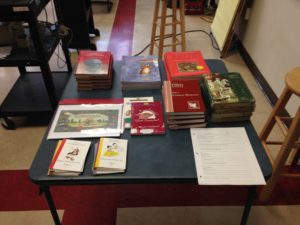[NB: This page has been updated, please go to this link first.
On this page, I track my own evolution of developing a FVR program, and offer tips and resources for teachers (mostly Latin) who want to establish their own FVR program. Here’s my (very humble) fvr/ssr bookshelf, with posters from Bryce Hedstrom’s website.

This photo was taken at the beginning of 2016-17, before I had acquired novellas.

(One year Later. This is the table of offerings for my Latin 1 students, 2nd semester. The absence of novellas WAS intentional, because they were still too difficult.)
First a few words on terminology: True FVR, that is Free Voluntary Reading, presupposes a wealth of reading resources, so that every student will find something that is a) at their level, and b) of interest to them. With new simple Latin novels coming out every few months, our field is slowly getting there, but in the meantime it might be more accurate to say that our goal is SSR (sustained silent reading) with the chances of FV happening increasing with each new resource.
UPDATE: see THIS PAGE for my FVR level system, where I label different books from A-E. Dan Stoa (link below) has a more refined ranking system.
Just published: my article on beginner novels in Teaching Classical Languages
http://tcl.camws.org/sites/default/files/TCL%208.2%20Piazza.pdf
Because most Latin teachers are new to this (myself included), I will present it as FAQ’s
Why should I devote precious class time to silent reading?
Studies show that language learners acquire most of their proficiency through reading that is interesting to them. Many students do not come from a household in which reading is a priority. You are helping students to acquire not only a language, but a lifelong relationship with the written word. Amid the hectic day of the bell schedule, this time is a welcome respite, even for the complainers. In addition, this time can also be restorative for teachers (as long as you are reading along with them, modeling the expectations)
How much time do you have students read, and when do you do it?
For the past two years, I have had my students do “lectio otiosa” or FVR, for the first 8-12 minutes of class, Tuesdays and Thursdays. When the timer goes off, I then give students 4 minutes to write a log entry. It is helpful to make this a regular routine, rather than doing it haphazardly.
What kind of materials are appropriate for a FVR library?
Anything that is EASY and INTERESTING for students. I realize that this is a pretty tall order when it comes to Latin. But more options are becoming available every day. Also, you can have your students create materials for a classroom library (see below).
As you can see in the above photo, I began my FVR program by using what I had–namely textbooks. On the top shelf, there are 5-15 copies of five different first-year textbooks. (Lower shelves contain more difficult Latin books, and English culture readers) I encourage students to begin with a textbook, and read the Latin stories from the beginning, until it gets too difficult for them, and then pick up another first year textbook, start at the beginning, and on and on (credit: Justin Slocum Bailey).
The most frustrating thing, is that the books that students want to read are far too difficult even for 3rd or 4th year students to read easily on their own. I am talking about all the wonderful translations of young adult fiction like Harry Potter, the Hobbit, Winnie the Pooh, The Wizard of Oz, etc. For beginners, I find it best to redirect all but the most gifted and/or motivated learners from tackling these works. Teachers have begun to write adaptations of some of these works, which makes them far more useful in a FVR library. For the most part, however, having these shiny books on your shelf only serve as reminders of how difficult Latin is, or can be–not a message we want to be sending to beginners.
This year, I have been expanding my collection of Loeb-style books and readers which have Latin and English on facing pages. There are legitimate arguments for and against having these options for students. Ideally, I would not want to have them, but until I have more simple and interesting options, I will include them.
I have funds to purchase books, but I don’t know what books to get.
If you have funds, I encourage you to purchase 3-5 copies of each of the simple Latin novels that are now available. In the last two years, we have seen the explosion of more than ten titles, where there were none. I was recently awarded a $750 grant, and I was able to purchase almost 100 novellas (at $5-7 each) for my classroom.
Can I make books, or better yet, have students make their own books for the library?
Yes. Here is a link to my 2nd year project in which students create storybooks for the library . Also, Mike Peto has posted simple ways to stock your library with illustrated storybooks.
How do I hold students accountable, and can/should I grade them on this?
There are a few ways to answer this question. I would begin with a simple reading log, in which students list the date, title, page numbers, and a brief summary (in English or Latin) of what they read. I stamp student log pages (containing 6 entries) every three weeks.
I would love to do this, but my students have a hard time doing independent work, and many of them do not have a culture of reading at home. How can I provide structure so that my students can participate in this, without undermining the “free” part?
I think that structure and follow up activities are central to a long-term successful FVR program. I am slowly increasing the structure and support as learn about effective ways to do so, without interfering with student enjoyment of what they are reading. Bryce Hedstrom and Mike Peto (links below) have extensive discussion of this, with examples and suggestions. One practice is to have a reading circle 4-8 of your most struggling readers during this time. I will be adding a few practices next year, such as introducing students to a book or reading every week, having students discuss their readings in small groups once or twice a month, and asking (not requiring) students to write brief reviews for the wall above the bookshelf.
What if I don’t have paper books, but my students have access to technology?
if you have access to computers or tablets, you and your students have many options. The challenge will be for you to guide students to appropriate level readings, and discourage them from skipping around too much. See links below for access to online readings
Helpful links for getting started:
Mille Noctes Story Archive. Lots of teacher- and student-created readings, based mostly on historical-mythological themes
Latina Hilara Story Archive. More entertaining stories for all levels of Latin.
Mike Peto
https://mrpeto.wordpress.com/2015/11/05/a-map-to-transitioning-your-class-to-fvr/
Bryce Hedstrom
Scroll down to “Establishing a Free Voluntary Reading Program on this page:
http://www.brycehedstrom.com/free-stuff
Lance Piantaggini (MagisterP) has also written about Latin FVR
https://magisterp.com/2016/12/22/fvr-library-easier-than-you-think/
So has Dan Stoa (Latin specific with a list organized by level):
https://comprehensibleantiquity.com/free-volunteer-reading/
